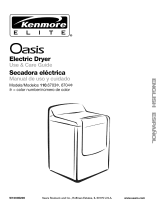
TABLE OF CONTENTS
DRYER SAFETY ..................................................................... 3
INSTALLATION INSTRUCTIONS ........................................ 4
TOOI.S AND PARTS .......................................................... 4
LOCATION REQUIREMENTS ............................................ 4
El ECTRICAL REQUIREMENTS - U.S.A. ONI.Y ................... 6
El ECTRICAI. REQUIREMENTS - CANADA ONI.Y ............. 7
ELECTRICAL CONNECTION - U.S.A. ONI.Y ..................... 8
VENTING REQUIREMENTS ............................................. 14
PI.AN VENT SYSTEM ....................................................... 16
INSTAI.I. VENT SYSTEM ................................................... 17
INSTAH. LEVEHNG LEGS ................................................ 17
CON NECT VENT ............................................................. 18
LEVEl. DRYER ................................................................... 18
REVERSE DOOR SWING (OPTIONAl.) ............................ 18
COMPI.ETE INSTA[ I ATION ............................................ 19
DRYER USE ......................................................................... 20
STARIING YOUR DRYER ................................................ 20
DRYING RACK OPTION ................................................. 21
DRYER CARE ...................................................................... 21
CI.EANING THE DRYER I.OCATION ............................... 21
C[.EANING THE [.INT SCREEN ........................................ 21
CLEANING THE DRYER INTERIOR ................................. 22
REMOVING ACCUMUI.ATED I.INT ................................ 22
VACATION AND MOVING CARE .................................. 22
CHANGING THE DRUM [IGHT ..................................... 23
TROUBLESHOOTING ........................................................ 23
ASSISTANCE OR SERVICE .................................................. 25
WARRANTY ....................................................................... 26
P
INDICE
SEGURIDAD DE LA SECADORA ....................................... 28
INSTRUCCIONES DE INSTALACION ............................... 29
HERRAMIENTAS Y PIEZAS .............................................. 29
REQUISITOS DE UBICACION ....................................... 30
RE(,)UISITOS EI.ECTRICOS - S(_)[O EN EE. UU ............... 31
CONEXION EI.ECTRICA - S(_)I.O EN EE.UU .................... 33
RE(,)UISITOS DE VENTII ACION ..................................... 39
PI.ANIFICACI(_)N DE[ SISTEMA DE VENTILACI(')N ....... 41
INSTAI.ACION [)El. SIS] EMA DE VENTHACI(')N ........... 42
INS] AI.ACI6N DE I.AS PATAS NIVEI.ADORAS .............. 42
CONEXION DEE DUCTO DE ESCAPE ............................ 43
NIVEI.ACI(')N DE LA SECADORA ................................... 43
COMO INVERTIR El. CIERRE DE LA
PUERTA (OPCIONAI) ..................................................... 43
COMPI.ETE IA INSTAEACION ........................................ 44
USO DE LA SECADORA .................................................... 45
PUESTA EN MARCHA DE SU SECADORA ..................... 45
OPCI(')N ESTANTE DE SECADO ..................................... 46
CUIDADO DE LA SECADORA .......................................... 47
EIMPIEZA DEI EUGAR DONDE ESFA EA SECADORA... 47
I IMPIEZA DEI. FII.TRO DE PEI.USA ................................ 47
EIMPIEZA DEE INTERIOR DE EA SECADORA ................ 48
El IMINACI(_)N DE PELUSA ACUMU[ ADA .................... 48
CUIDADO PARA LAS VACACIONES Y LA MUDANZA. 48
CAMBIO DE IA EUZ [])EI. TAMBOR ............................... 48
SOLUClON DE PROBLEMAS ............................................ 49
AYUDA O SERVICIO Tf_CNICO ........................................ 51
GARANTIA ........................................................................ 52
TABLE DES MATIERES
Sf_CURITI!DE LA Sf_CHEUSE .............................................. 54
INSTRUCTIONS D'INSTALLATION .................................. 55
OUII[ I.AGE ET PIECES .................................................... ._.5
EXIGENCES D'EMPLACEMENT. ...................................... 56
SPECIFICATIONS I_LECTRI()U ES...................................... 57
EXIGENCES CONCERNANT I 'EVACUATION ................ 58
PI.ANIFICATION DU SYSTEME D'EVACUATION ........... 60
INSTALI.ATION DU SYSTEME D'EVACUATION ............ 61
INSTAI.I.ATION DES REDS DE NIVEH.EMENT. .............. 61
RACCORDEMENT DU CONDUIT D'EVACUATION ...... 62
MISE _, NIVEAU DE I.A SECHEUSE ................................. 62
INVERSION DU SENS D'OUVERTURE DE I.A
PORTE (FACUI.TATIF) ..................................................... 62
ACHEVER I.'INSTAI.I.ATION ........................................... 63
UTILISATION DE LA SECHEUSE ....................................... 64
MISE EN MARCHE DE I.A SECHEUSE ............................. 64
OPTION GRIH.E DE SECHAGE ....................................... 65
ENTRETIEN DE LA SI_CHEUSE ........................................... 66
NEFTOYAGE DE I.'EMPI.ACEMENT DE I.A SECHEUSE... 66
NETTOYAGE DU FILTRE _, CHARPIE ............................. 66
NETTOYAGE DE [ 'IN-I ERIEUR DE IA SECHEUSE ........... 67
COMMENT ENLEVER I.A CHARPIE ACCUMUEEE .......... 67
PRECAUTIONS _, PRENDRE POUR IES VACANCES ET
AVANT UN DEMENAGEMENT ....................................... 67
CHANGEMENT DE I'AMPOUI E DU TAMBOUR .......... 67
Df_PANNAGE ..................................................................... 68
ASSISTANCE OU SERVICE ................................................. 70
GARANTIE ......................................................................... 71
2




















